Real World Rides: Honda Talon, Tucson Episode 1
Also posted to:
Real World Rides: Honda Talon, Tucson Episode 1
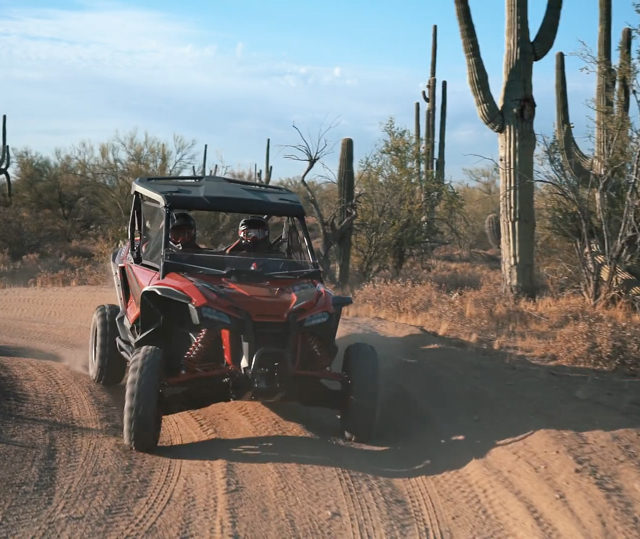
We’re giving real potential SXS customers the keys and letting them tell us what they think of the Honda Talon SXS.
Welcome back to the Real World Rides: Honda Talon, Tucson series. We’re taking prospective Side-by-Side buyers Brent and Haley through a unique testing and driving experience on the all-new Honda Talon 1000R. And we’re ready to get started!
In our Preview Story of this series, we introduced you to Brent and Haley, went over their backgrounds including off-road riding experiences and their current desire to include a side-by-side vehicle into their lives. We also briefly recapped our own Honda Talon First Impression after our first couple days driving the new vehicles at the press introduction outside St. George, Utah earlier this year.
Well, now we’re fully embedded in Tucson, Arizona and getting started with our Real World Rides test. Come along as we give a quick introduction to Brent and Haley on-camera, as well as a bullet-point overview of the features and benefits of the Honda Talon 1000R. Then, we let them go for a rip and give their first impression review after a ride in their backyard riding areas around Tucson.
You can watch episode 1 of Real World Rides: Honda Talon, Tucson below. And, if you’d like to learn a little more about the Honda Talon and riding in the Tucson area, keep reading. The features of the Honda Talon 1000R that caught Brent and Haley’s attention the most are in detail below.
Honda Talon 1000R vs Honda Talon 1000X
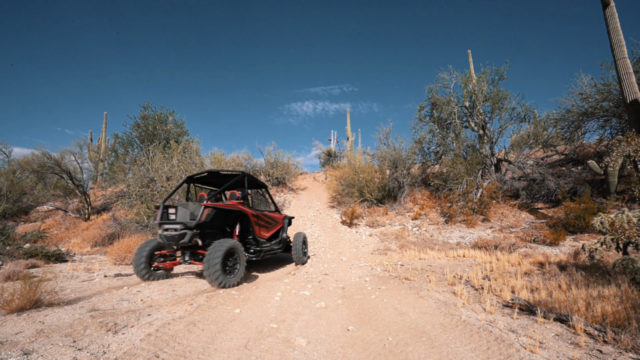 We let Brent and Haley put the Honda Talon to the test in their own local riding area.
We let Brent and Haley put the Honda Talon to the test in their own local riding area.
The reason we chose the Honda Talon 1000R and not the Honda Talon 1000X for this test is simply about proximity. The southwestern United States is full of open terrain and fast tracks where the longer and wider 1000R can stretch it’s legs a little more than the more nimble and technical-terrain focused 1000X.
We won’t cover this in the video series, but this is a great time to go over the big differences between the two Honda Talon models. A lot of people are weighing their options and knowing where and how you’ll drive the Honda Talon will likely determine which is the best for you.
Since terrain and riding areas vary across the country, Honda has wisely introduced two variants in their initial Honda Talon vehicle lineup.
The Honda Talon 1000X continues the heritage of other “X” models in the Honda powersports lineup—serious race-winning machines that are designed for rigorous off-road performance. The CRF-X lineup of off-road motorcycles started this trend after a seamless handoff from the legendary XR lineup of bikes. The X’s legacy of desert wins and championships is unmatched. The “X” bikes’ Baja 1,000 performance is staggering, and it keeps performing at the top level of off-road sport. So, they’re going with a good thing here in the X world.
The Honda Talon 1000X is narrower than the Honda Talon 1000R, has a shorter wheelbase, and shorter suspension travel. The machine is designed for tighter, more technical trails where being nimble and agile makes more of a difference in the ride quality than having the biggest suspension movement on the block. The X is at home in the mountains, navigating root-infested two-track and slicing around tighter switchbacks.
The Honda Talon 1000X comes in with a 64-inch width, 87.6” wheelbase, 14.6” of front suspension travel and 15.1” of rear suspension travel. The Honda Talon 1000X has an MSRP of $19,999 (2019 model at time of press launch)
The Honda Talon 1000R also follows a direct performance path laid down by Honda’s Powersports lineup. Honda’s CRF-R machines are the most aggressive, highest-performing competition motorcycles in the company. They are purpose-built to go faster, jump higher, react quicker and decimate the competition. Honda’s legacy of Supercross and Motocross success plays a big role in driving the products with an “R” moniker. So, it makes sense that the Honda Talon 1000R slides into the more aggressive spectrum.
The Honda Talon 1000R is wider and longer with massive suspension travel. It’s at home blitzing the whoops and taking on the harshest g-outs the open terrain of deserts and sand-dunes can dish out. It tracks better through previously-ran racecourse roads, proves to float more easily across higher speed washboards and stutter-bumps and just behaves nicely at higher speeds throughout a wide-open day.
The Honda Talon 1000R measures 4.4 inches wider than the Honda Talon 1000X at 68.4 inches. Its wheelbase is 4.9 inches longer at 92.7 inches and the suspension travel increases considerably. The front suspension travel is 3.1 inches more at 17.7 inches total and the rear boosts 5 inches over the 1000X at a whopping 20.1 inches.
When choosing a new Honda Talon SXS, the choice simply comes down to terrain. If you’re going to be carving tighter lines and crawling through narrow gaps, the 1000X and its more compact wheel placement and more agile suspension travel is the right ride for you. If you’re going to be driving faster across rougher terrain and more open landscapes, the 1000R and its larger footprint and longer suspension travel is your ride.
Off-Road in Tucson, Arizona
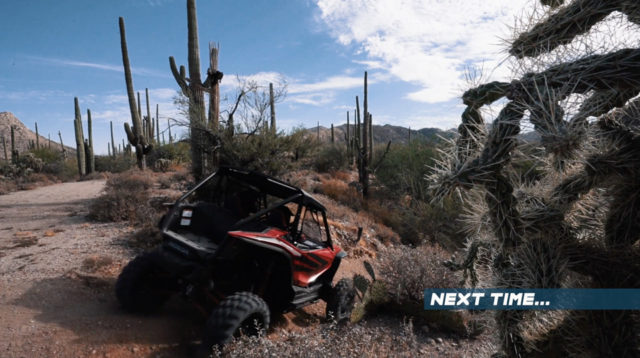 We go into the aftermarket game on the next episode of Real World Rides: Honda Talon, Tucson.
We go into the aftermarket game on the next episode of Real World Rides: Honda Talon, Tucson.
It’s pretty clear why we chose the Honda Talon 1000R for our Real World Ride in Tucson. The desert in Tucson is big, with valleys stretching between impressive mountain ranges in nearly every direction. Even though it looks vast and open, the roads and trails are very defined thanks to foreboding vegetation that keeps vehicles contained to certain routes and tracks.
Home to the Saguaro cactus—the nation’s largest cacti (and nearby Saguaro National Park), Tucson enjoys some of the most scenic, iconic American West landscapes in the world. If you’re considering a road trip to drive a SXS, heading to Tucson and the surrounding deserts should be on your list.
Yes, you can get into some technical, rocky terrain as you approach the foothills in Arizona, but for the majority of the rides, the 1000R and it’s open-terrain bias is going to be the best choice.
Real World Rides: Honda Talon, Tucson First Impressions
While they’re in the market for a SXS, Brent and Haley hadn’t actually seen a Honda Talon until we unloaded it from the trailer. They really liked the way it looked and while they’ve watched a few videos and read some reviews about it, they were basically newbies when it came to the details of the machine.
We went around the vehicle and called out the features and benefits (you can see this in the video). And a few things really stood out to them.
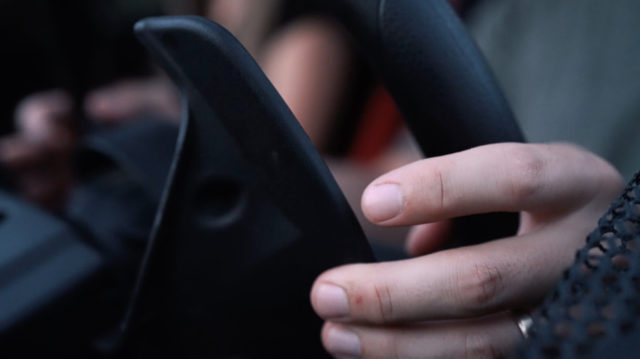 The Honda Talon features a six-speed dual clutch automatic transmission that is either fully automatic in two modes or can be manually overridden with race car-style paddle shifters. It was an impressive part of the Honda performance for our test riders.
The Honda Talon features a six-speed dual clutch automatic transmission that is either fully automatic in two modes or can be manually overridden with race car-style paddle shifters. It was an impressive part of the Honda performance for our test riders.
First, the six-speed automatic DCT was a big eye-opener for them. All their SXS experience is with CVT-style transmissions and they honestly weren’t totally sure what Honda’s DCT even was. Once we explained that it was a gear-driven, automatic transmission with dual clutches for increased durability, they were intrigued before driving.
Having a manual override via the on-wheel paddle shifters and the option to put the automatic transmission in Sport mode really opened up their eyes.
“The DCT transmission sounds like it basically takes any driving issues or durability issues out of the equation,” Brent said. “I like that it’s an automotive-style transmission and having the paddle shifters to go in manual mode, and a more aggressive Sport should be a lot of fun to experience.”
We constantly hear this reaction when discussing Honda’s DCT. It’s a standout feature in powersports and we’ve tested DCT on Honda’s Africa Twin via our sister publication Cycle News multiple times. It simply works, intuitively, and continues to impress us with its overall usability. For us, DCT is a winner every time we try it. We’re excited to find out what Brent and Haley think.
Next up, the cockpit comfort and ergonomics stood out for Brent and Haley. They commented the Honda Talon was easier to get into and out of than other SXS’s they have used and the seats were comfortable. They would like to see more aggressive harnesses installed standard as they put it, “everyone is going to want a multi-point harness in their SXS anyway.”
The rest of the vehicles features, and benefits seemed to fit with Brent and Haley’s intended use across the board. From suspension travel to the power output, the Honda Talon 1000R seems like a good choice for them as they geared up for a ride.
After the First Ride on the Honda Talon 1000R
Brent and Haley aren’t new to off-road, the desert or even SXS driving. They drive their friends’ and families’ SXS often and grew up riding from Arizona to California in the American Southwest on bikes, quads and the like. So, it didn’t take long for them to feel comfortable buckling in and kicking up some dust in the Honda Talon 1000R.
Their first impressions were positive—much like our first drive impressions were in Utah. And you can hear all about them in the video. But without leading into any details in particular, Brent—the primary driver of the duo—found something that performed way above his, and our expectations.
Honda I-4WD for the win
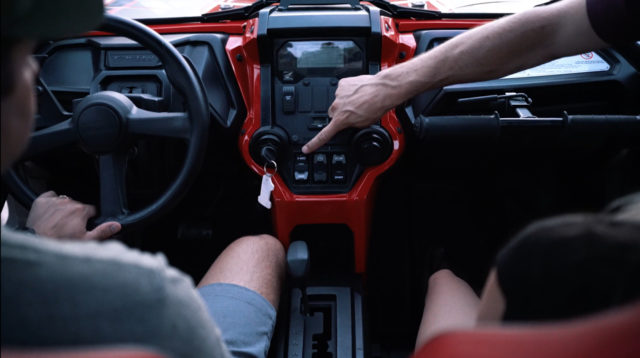 The Honda Talon features a simple dash with easy-to-access controls for ride modes and accessories.
The Honda Talon features a simple dash with easy-to-access controls for ride modes and accessories.
The Honda I-4WD system is a very unique piece of off-road technology that incorporates wheel brake force technology to direct wheel-turning power to those with more traction. It does this by activating the brakes on wheels that are slipping. As engine torque transfers to grounded wheels or those with more traction than others, the result is drive force moving the vehicle forward. Honda describes it as if you had a locking front differential when wheels slip and a free differential when they’re all gripping. In theory, it should provide extremely high levels of traction with nimble handling.
Well, right away we hit some very fun, slot-car-style two-track trails just outside Tucson’s city limits. The roads and trails are well used, and it’s July, so the terrain is hard with a layer of loose, marbled dirt on top. This makes for an extremely slippery surface for drive wheels and for steering even if you’re driving in slotted tracks.
With I-4WD activated, the Honda Talon 1000R was absolutely stuck to the ground on all four corners with massive traction driving the vehicle through turns and accelerating in the straights. If ever a front wheel threatened to spin, the power was diverted from the wheel loosing traction to the others and the vehicle would literally grab some grip.
While Brent and Haley thought 2WD would be the most fun in slippery stuff, it turned out the I-4WD system turned the Honda Talon 1000R into a finely tuned rally car, pulling the driver and passenger around corners with serious traction.
This was a fun discovery, as our test days in Utah had us in soft sand or hard rocks, nothing really in-between. Here, with loose traction on top of hardpack, having on-demand drive force really shined. This felt like an AWD car ripping through the snow—it was absolutely controlled, and the front end went right where you pointed it. It was a seamless showcase of how traction can be used to simply increase speed and control.
No, I-4WD doesn’t really let you drift, but if going forward as fast as possible is your main objective, it’s worth a shot!
Next up, we take the stock Honda Talon 1000R and throw Honda’s Parts and Accessories catalog at it to explore some increased usability and convenience in the driving experience. Watch for Episode 2 of our Real World Rides: Honda Talon, Tucson series coming soon.
